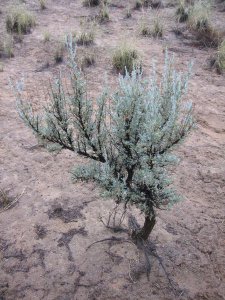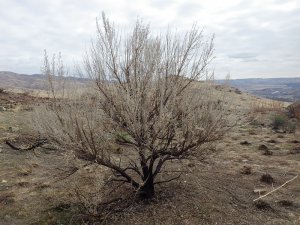An Introduction to Sage brush:
Artemisia tridentata or sage brush as it is commonly known is a fragrant herb with a strong, woody build which prefers dry area which have a colder temperature than normal including mountainous or some specific desert regions. It is quite popularly considered good to start and use in to make fires. Other than being used as firewood it also has been used in medicine, all of which we will look into further. A true Historical Native Herb.
Places where you can spot Sage brush:
As mentioned earlier you may come across sage brush in dry places in North or Central America with a cold climate. Places surrounding New Mexico may be good for starting to look for it. Mountain steppes may serve as the go to places to search for the herb or even some deserts such as those near the Dakota region.

Physical Appearance:
Sage brush is a shrub-like herb which is very bristly to say the least. This herb may grow to upwards of feet which is astonishing. It has yellow flowers with near silver colored leaves which adds more to its appeal. To add more to its description it has a potent overpowering scent due to various compounds within the plant. tramadol for dogs online uk https://99percentinvisible.org/ order tramadol 50 mg
The shape of its flowers is more tubular and the flowers are present in bunches. The leaves of the plant are about 1 inches long (each) about half an inch or less wide and end in small parts that project out.
The means of reproducing for this plant may be in the form of making sprouts. They sprout from a rhizome from beneath the ground and grow from there on.

Distribution and importance:
Like mentioned before, Sage brush hails from parts of North and Central America. It is distributed among places with colder climates but also dry too. Places like deserts which may not be as hot or mountainous places are ideal for the plant. This plant can be found in British Columbia and can reach to parts of California; or maybe even further.
The role of this Native Herb in Cooking:
Sagebrush can be used in preparing a lot of dishes. These dishes may include drinks such as those which various fruits in them. Mostly cocktails are made with the help of sage brush as a good additive in the form of a flavor booster. It can give that small bit fragrance that a drink might need but be careful not to put too much.
The Native Americans used to make flour from the seeds of sagebrush which would later on become a normal part of their day to day diet.
The Medicinal Uses of this American Native Herb:
Some medicinal use methods date back from quite a long time ago. Native Americans used to make pastes and salves out of sage brush to treat various wounds and other injuries. Some Native American nations even used sagebrush to treat to headaches. Others would use it for getting rid of pain in various parts of the body.
It was also used as a primitive deodorant. It may be even used to make one even now but it depends on what perfume manufacturers want these days.
Beware however, as this herb can be toxic if taken in excess. It has been known to contain amounts of camphor and other worrisome substances that may cause health problems. So, consult a nutritionist or any other experienced person before taking it. These substances may harm the liver if taken in excess. Thus, it would be wise to consume it in moderation. A healthy amount now and then would be enough but it would be wise to consult a nutritionist or your primary health practitioner.
Conclusion:
To sum it up Sage Brush is quite a versatile herb with uses of all kinds; ranging from culinary to medicinal. It has a history dating back from when the Native Americans were widespread across the country. If you want that fragrant herby touch in your food or something else, give this a try but make sure that this is suitable for you.
Many of our readers find that subscribing to Eat The Planet is the best way to make sure they don’t miss any of our valuable information about wild edibles.
var gCaptchaSibWidget;
var onloadSibCallback = function() {
var element = document.getElementsByClassName(‘sib-default-btn’);
gCaptchaSibWidget = grecaptcha.render(element[0],{
‘sitekey’ : ‘6Ld5UPEhAAAAAC8Ax6SnRJ8wjEg9yV3xNmVZZtSZ’,
‘callback’ : sibVerifyCallback
});
};
https://www.google.com/recaptcha/api.js?onload=onloadSibCallback&render=explicit

Leave your email address so you don’t miss any of our wild edibles info!
.email-input { margin-bottom: 10px; width:100%; border:2px solid #aaa; border-radius:4px; outline:none; padding:16px; box-sizing:border-box; transition:.3s; } .email-input:focus { border-color:dodgerBlue; box-shadow:0 0 8px 0 dodgerBlue; } .sub-button-style { padding: 10px; border-radius: 5px; background-color: #162115; border: none; color: #f7f7f7; width: 100%; }form#sib_signup_form_2 p.sib-alert-message {
padding: 6px 12px;
margin-bottom: 20px;
border: 1px solid transparent;
border-radius: 4px;
-webkit-box-sizing: border-box;
-moz-box-sizing: border-box;
box-sizing: border-box;
}
form#sib_signup_form_2 p.sib-alert-message-error {
background-color: #f2dede;
border-color: #ebccd1;
color: #a94442;
}
form#sib_signup_form_2 p.sib-alert-message-success {
background-color: #dff0d8;
border-color: #d6e9c6;
color: #3c763d;
}
form#sib_signup_form_2 p.sib-alert-message-warning {
background-color: #fcf8e3;
border-color: #faebcc;
color: #8a6d3b;
}
Like our facebook page for additional articles and updates.
![]() Follow us on Twitter @EatThePlanetOrg
Follow us on Twitter @EatThePlanetOrg
See our privacy policy for more information about ads on this site







4 Responses
Hmm, didn’t know sagebrush had so many possible uses. What does it taste like?
Does sagebrush make a yeast that can be used in bread?
I am looking for the same answer.
I have a very negative reaction to sage, an allergy perhaps. My throat starts getting tight and my nose and breathing become restricted its very uncomfortable and i didnt realize it was from the chemicals in Sage, So sage has interesting uses its not for everyone.